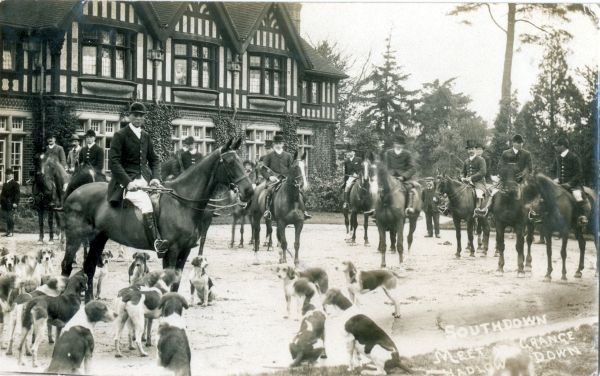John Frisby (and F. S. Frisby)

Southdown Hunt meet at the Grange, Hadlow Down (June 1913 postmark)
Photographer, Birdeye Terrace, 129 Framfield Road, Uckfield. John Frisby was born on August 16, 1843 at Kilsby, Northamptonshire, not far from Rugby (see Mick Harker, "Seen through the lens- early photography in Uckfield", Hindsight, 2008, volume 14, pp. 27-32, Uckfield & District Preservation Society). He was the son of Samuel Frisby, the landlord of the Red Lion Inn at Kilsby, and his wife, Elizabeth. At the age of 23 John moved to Marylebone in London, where he became a grocer. In 1867 at All Souls' Church in Langham Place he married Sarah Woodford, who came from Kilsby and may have been a childhood sweetheart. When the 1871 census was held, Frisby was working as a dairyman. He and his wife lived in Mortimer Street in Marylebone and had a 2-year-old son, John E. J. Frisby and 1-month-old daughter, Amelia (Fanny) Frisby, who had both been born in Marylebone. A third child, Horace Mortimer Frisby, was born at Mortimer Street in 1873.
Frisby and his family returned to Northamptonshire in 1873 to the village of Crick where for six years he worked as a newsagent. Three more children were born at Crick: Gertrude Mary Frisby in 1875, then Frank Simmons Frisby in 1877, and lastly Frederic Frisby in about 1880. When the 1881 census was held, Frisby was running the George Inn at Kilsby in competition with his father, who still held the Red Lion. He then moved with his family to Rugby and started another grocery business. What happened next remains obscure, but by the time the 1891 census was held, Frisby had moved to Uckfield to work as a photographer and was boarding with a Mrs Mary Smith in the Framfield Road, presumably while searching for a suitable house for his family. The 1901 census records that he and his wife were living at Birdeye (or Bird-in-Eye) Terrace in Framfield Road, Uckfield, with their eldest daughter, Amelia (who had become Frances Amelia Webb), and her daughter, Hilda Frances Webb, aged 4 months.
In their book Bygone Uckfield (1988, Phillimore, Chichester) B. Fuller and B. Turner reproduce a studio portrait of John Frisby, together with another photograph showing him walking along a street carrying his heavy camera tripod. They describe him as "one of the most important early photographers of Uckfield".
Frisby greatly preferred landscape photography to portrait work. He spent much time recording scenes in the Uckfield area, often travelling around in a trap pulled by his white pony, which he stabled at the Alma Arms near his home. Owners of fine houses and gardens often commissioned him to photograph their property. The infamous Charles Dawson employed Frisby to illustrate his monograph on Hastings Castle and to make a photographic record of the archaeological excavations at Piltdown following Dawson's "discovery" of Piltdown Man. Frisby published a card showing the now wholly discredited Piltdown skull as "reconstructed" by Dawson.
Frisby was a major publisher of black and white and also sepia real photographic cards of Uckfield and district. Some cards have survived in fine condition, but others are annoyingly faded. Often there is a printed label on the back: "J. Frisby. Uckfield". However, anonymous cards can also be found. The captions were written directly on the negatives in mirror-fashion, but occasionally mistakes were made and the letters appear the wrong-way round. On many cards the captions are written in a distinctively "fancy" style, in even sized blocky capitals except at the start of words where the letters are extra tall. Some capitals (especially Y and R) tend to be embellished with descenders. The uprights of Hs often curve inwards. By contrast, other cards have captions written in a much plainer style, with all letters the same height and with no descenders. The two styles suggest that at least two different people wrote the captions on the Frisby cards. One of these may have been Frisby's son, Frank Simmons Frisby, who can be presumed to have helped run the business (he may have taken over from his father) because some cards are actually labelled on the back: "F. S. Frisby".
Places shown on Frisby's cards include (besides Uckfield) Laughton, Sheffield Park, Danehill, Chelwood Gate, Buxted, Framfield, Maresfield, Little Horsted, Hadlow Down and Eridge (castle, lake and rocks). Two cards record a hunt meeting at Newick (a 1914 postmark has been noted), and other cards portray hunt gatherings at Hadlow Down, Heathfield, Eridge, Eastbourne and elsewhere in Sussex. One gains the impression that Frisby was a keen spectator at local fox hunts. Two particularly well known cards show a team of oxen that was kept at Possingworth Park. Cards of Blackboys and Cross-in-Hand windmills are also much valued by collectors. Frisby's real photographic "Searching for the Piltdown Man" is an interesting photomontage as well as an embarrassing reminder of a serious scientific fraud. One anachronistic card that he published at least five years after the event depicts the railway accident on the Cuckoo Line between Heathfield and Mayfield on September 1, 1897, when a class D1 tank engine derailed on the twisting, bumpy track, killing the driver and injuring some passengers.
Although real photographic cards formed the bulk of Frisby's output, he also issued some collotype cards. He retired as a photographer in about 1923, and died in 1929, in his mid eighties.
Frank Simmons Frisby died at Uckfield in 1957, aged 80.
To directory of publishersTo gallery
Design: Lucid Design
© www.sussexpostcards.info
